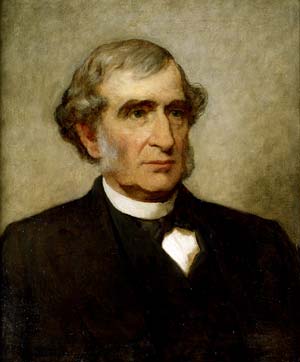
History of Extension: Research, Teaching, Extension
The development of the integrated land-grant mission of Teaching, Research and Extension grew out of a need to secure and grow the economic, social and environmental resources of the struggling young nation.
In the early 1800’s, 85% of the employed population or 4.3 million people farmed. George Washington experimented with wheat seed selection and as president influenced congress to establish a national agricultural agency. Thomas Jefferson developed new farm machinery and experimented with crops. Benjamin Franklin organized the first Philadelphia Society for Promoting Agriculture and by 1861 there were 900 agricultural societies studying and adapting agriculture to American farm conditions. In 1811 the Berkshire Agriculture Society in Massachusetts promoted the improvement of cattle through livestock fairs by awarding premiums. Agricultural societies published journals and sponsored educational programs and invited visiting lecturers from colleges.

Teaching at Land GrantsEstablished by the Morrill Act
Michigan became the first state to establish a college of agriculture in 1855 and Pennsylvania established an agricultural high school in 1855 which became the state’s land grant college – Pennsylvania State University. In 1857, Representative Justin Morrill of Vermont introduced the land-grant bill to Congress. This bill donated federal land to each state and territory for an endowment to establish at least one college in each state where: “the leading object shall be, without excluding other scientific or classical studies, to teach such branches of learning as are related to agriculture and the mechanic arts.” President Abraham Lincoln signed the Morrill Act into law in 1862. Iowa was the first state to accept the conditions of the Morrill Act. Also in 1862, Congress created the U.S. Department of Agriculture.
Research at Land GrantsEstablished by the Hatch Act
The new agricultural colleges struggled to attract students and solve problems. Wilbur Atwater in 1857, established the first agricultural experiment station in Connecticut. Professor Seaman Knapp proposed uniting the experiment states with the agricultural colleges to build a stronger program. In 1887, the Hatch Act provided for an experiment station in each college. These stations were required to publish bulletins about the research projects.
The Morrill Act of 1890 established 16 black land-grant colleges in the South and gave land grant status to Tuskegee Institute. It also provided for more funding of all land-grant colleges.
The concept of “University extension” or non-credit classes began in England in the late 1800’s. In the United States, Rutgers was one of the first colleges to offer off-campus courses and Ohio State University began offering on-campus non-credit instruction. During the same time, Farmers Institutes were held by experiment station staff and Washington Carver developed a popular idea of the “movable school”. Seaman Knapp continued to grow the idea of demonstration farms and on-farm research in Texas where in 1904, 7000 demonstrations for cotton farmers facing boll weevil problems were conducted by “special agents”.
Boy’s and Girl’s clubs sprang up in New York and Ohio with projects growing corn and gardens. Two Iowa leaders Jesse Field and O.H. Benson, introduced clubs to rural schools along with the idea of the three-leaf clover as the club emblem. A Nebraska association is credited with the development of the hand, head, and heart parts of the 4-H creed. Health was added years later. Also during this time home demonstration clubs for women taught nutrition, sanitation and thrift.
Extension at Land GrantsEstablished by the Smith-Lever Act
Congress passed the Smith-Lever Act in 1914, in an effort to extend Seaman Knapp’s philosophy of farmers’ cooperative demonstration work. This act created a third component of the land-grant mission – Extension. It helped define the role of the federal, state and local partners. It also established agents in agriculture, home economics and 4-H. National program leaders were also funded for USDA. In 1953, Public Law 83 broadened the work to related subjects adding programs in health, Native American programs and Expanded Food and Nutrition Education programs.
1994 Tribe Colleges
In 1994 LG Institutions were set up as Tribal College (Native American) land grant institutions (much later than the 1862 and 1890 LGI’s). In 1994, the board of National Association of State Universities and Land Grant Colleges (NASULGC) voted to admit American Indian Higher Education Consortium (AIHEC) as a system member of the association. “Land grant status was conferred on the Native American colleges in 1994 as a provision in the Elementary and Secondary Education Reauthorization Act". Funds were authorized for the new 1994 LGI’s and “The legislation also provided $5 million to go to the Cooperative Extension Service of the 1862 LGI’s in states that also have tribal colleges. The 1862 institutions were to cooperate with the tribal colleges in setting up joint agricultural extension programs focused on the needs of Native American Institutions, as identified by the tribal colleges.”
Nebraska Indian Community College (NICC) currently receives funds from National Institute of Food and Agriculture (NIFA) Tribal College (TC) Endowment, TC Equity grant program, TC Research grant program, TC Extension Services grant program (NICC Project Morning Star and NICC Project New Day).
Current Nebraska Tribal Colleges:
- Nebraska Indian Community College, Macy, Nebraska
- Little Priest Tribal College, Winnebago, Nebraska
Sources
The Land Grant Tradition, Development of the Land-Grant System: 1862 – 1994 (NASULGC, 2000.)
Seevers, B., Grahm, D., and Conklin, N. 2007. Education Through Cooperative Extension. Ohio Agricultural Education Curriculum Materials Service.